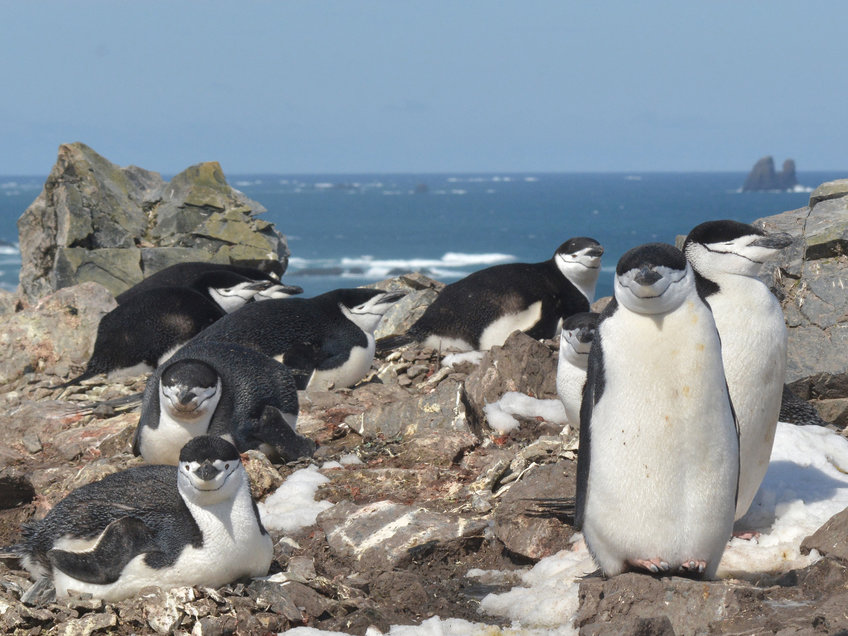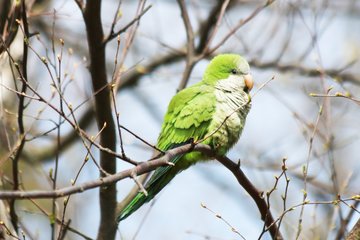Penguins obtain large quantities of sleep via seconds-long microsleeps
New study shows the most fragmented sleep ever recorded in an animal
When breeding in a dangerous environment, chinstrap penguins usually do not nod off for more than four seconds at a time. However, they still get up to twelve hours of sleep in total thanks to over 600 such microsleep phases per hour - and over 10,000 per day. The animals sleep alternately with both hemispheres of the brain as well as with the whole brain. Despite and probably also because of the extremely fragmented sleep, the animals are able to reproduce successfully under difficult ecological conditions. This is shown in a new study by an international team of researchers from Lyon and Korea with the participation of Niels Rattenborg from the Max Planck Institute for Biological Intelligence.

Animals, ranging from jellyfish to humans, spend large amounts of time asleep. Several lines of evidence indicate that sleep plays an important role in maintaining adaptive waking cognitive performance. Indeed, sleep loss, a growing problem in our noise- and light-polluted 24/7 societies, has a detrimental impact on our ability to interact with the environment. Notably, insufficient sleep leads to nodding off, the seconds-long interruption of wakefulness by eye closure and sleep-related brain activity. The consequences of such microsleeps are usually considered negative, especially when nodding off occurs while driving a motor vehicle. But, can microsleeps provide any of the benefits of sleep? Or, are they simply too short for sleep to perform its functions?
This article describes for the first time an animal successfully breeding in the wild despite obtaining extremely fragmented sleep. While incubating eggs, chinstrap penguins accrue large quantities of sleep through thousands of seconds-long microsleeps. Despite sleeping in this unusual manner, the penguins were able to successfully raise their young, suggesting that restorative functions of sleep can be achieved via microsleeps. This unprecedented sleep pattern is likely an adaptation to the constant presence of brown skuas (an egg predator) and a response to noise and aggression from other penguins in the colony.
Researchers from the Neuroscience Research Centre of Lyon, the Korean Polar Research Institute and the Max Planck Institute for Biological Intelligence in Germany recorded for the first time the behavior and brain activity of wild chinstrap penguins breeding on King George Island, Antarctica, using custom-engineered data loggers that recorded brain activity. Penguins were recorded for eleven days, on land and while at sea, diving up to a depth of 200 meters. Researchers examined how nesting at the colony border, where penguins are exposed to brown skuas, versus in the hustle and bustle of the colony center, impacted their sleep. Slow wave sleep, the predominant type of sleep in birds, including penguins, occurred in both hemispheres simultaneously (bihemispheric slow wave sleep) or in one hemisphere at a time (unihemispheric slow wave sleep). Episodes of all types of slow wave sleep were extremely short, usually lasting just a few seconds. Even when consecutive bouts of different types of sleep were combined, the vast majority lasted less than five seconds.
Behaviorally, this sleep fragmentation manifests as frequent closing and opening of one or both eyes (video). Despite engaging in short episodes, each brain hemisphere obtained 11.5 to 12 hours of slow wave sleep per day, distributed evenly across the 24-h day, with over 500 episodes per hour.
Microsleep in chinstrap penguins
Based on previous work on ducks, the authors expected penguins exposed to predators at the colony border to sleep less and to engage in more unihemispheric sleep. Instead, they found that birds at the border slept ten percent more, in 40 percent (1 second) longer bouts, and did not engage in more unihemispheric sleep than those nesting in the center. This unexpected finding suggests that disturbance and aggression from other penguins within the colony has a greater impact on sleep than exposure to predators.
Finally, the researchers demonstrated that penguins could sleep while floating on the sea. Although they slept less than on land, slow wave sleep was more consolidated and almost exclusively bihemispheric. Once back on land, sleep lost at sea was partially recovered, albeit still in bouts lasting just four seconds. The persistent sleep fragmentation exhibited by penguins under all conditions on land is likely an adaptation to visually monitor the environment for predators and conspecifics.
Collectively, this paper demonstrates that chinstrap penguins are able to successfully breed under real-world ecological circumstances, despite accruing sleep via seconds-long microsleeps. Consequently, in at least some species, this work suggests that sleep functions can be achieved through engaging in thousands of microsleeps per day.
---
This text corresponds to a press release by the Lyon Neuroscience Research Centre, France.












